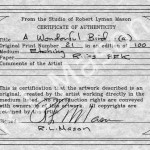Archive for September, 2008
Prologue
The stretch of coast between Half Moon Bay and Point Año Nuevo, California is one of my favorite settings. In total, it is perhaps only twenty miles or so and includes the villages of San Gregorio and Pescadero.
While driving south from Half Moon Bay, on the left is rolling agricultural land and on the right a view of surf, cliffs, and rocks. Highway One becomes an ecotone between pastoral and marine. Looking out to the horizon you can often see ships, fishing boats, and occasionally the spout of a gray whale as it migrates north or south along the coast. About half way between Pescadero and Año Nuevo is Pigeon Point which is graced by a lighthouse straight from a picture book.
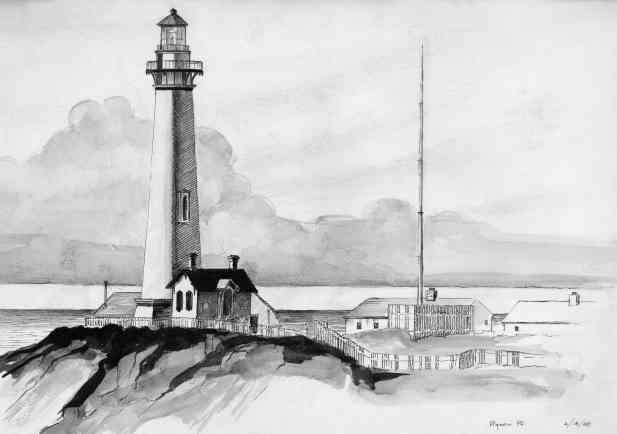
Lighthouse at Pigeon Point
Pigeon Point was my destination early in the spring of 1986, as it had been many times before. It is a truly magical spot and it’s my favorite place to watch the Sun set. As I drove south in the late afternoon light, I was once again struck by the beauty of the area. All the hills were green with spring, and fleecy clouds left over from a late season storm were blowing in from the horizon. Row upon row of artichokes flashed by to my left while cattle and sheep could be seen grazing on the hills in the distance.
Since Pigeon Point is only an hour’s drive from Palo Alto, I often went there when I needed a break in my daily routine. It has the advantage of being close while seeming far away. As the light fades, the sound of surf predominates along with the flash of the beacon at the lighthouse. One could, at that time, park right on the edge of the cliff and look down about 40 feet to the surf dashing against the rocks below. Low tide reveals a plethora of tide pools. At night the lights of the fishing boats are stippled along the horizon and, when the moon is not out, the milky way is plainly visible. You sleep to the primal rhythm of the surf. Eternal . . . eternal . . . eternal; the sound of the surf is one of only a few sounds I can think of that connect us so directly with the eternal.
Upon arriving that evening in 1986, I settled down with a glass of wine just north of the lighthouse. As I watched the Sun slip out of sight, I wondered if I would find a spot to match this during my trip north. Maybe, and what else would I find . . .
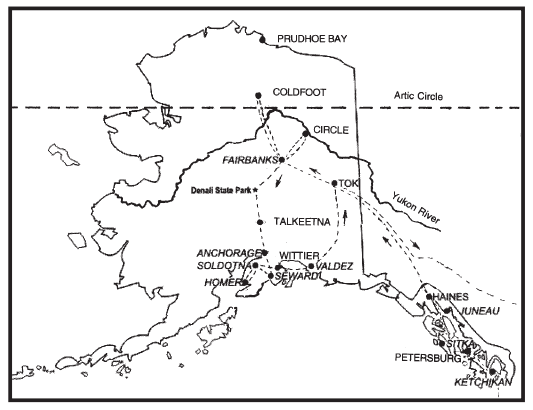
Alaska Travel Route

Introduction
Starting in May of 1986, I took a year off from my regular position as Artist-in-Residence for the Pacific Art League in Palo Alto, California. Having hired and trained an assistant to run my framing business, I intended to take a sabbatical and see some of the United States. Two fine books, Travels with Charlie by John Steinbeck and Blue Highways by William Least Heat Moon, helped inspire my decision to make such a trip. In addition, I wanted to sort out some philosophical thoughts I had been mulling over in my mind for a number of years. Such a trip would provide the opportunity. To begin my wanderings, I decided the first leg should go as far north as possible and that led me to Alaska. This book chronicles that journey.
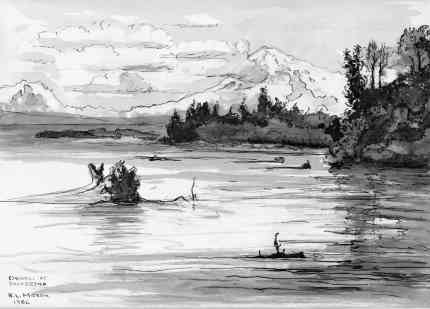
Denali at Talkeetna by R L Mason
Somewhere I had heard of the Japanese custom of keeping a “legacy,” a large book in which the head of a family wrote down his thoughts on life and other matters. The book was passed down through the generations with each successor adding his own thoughts. This practice appealed to me since I was curious about my ancestors and yet knew so little about them. Also, I was fascinated with the enduring nature of books. I had read the Autobiography of Benvenuto Cellini and the Travels of Marco Polo. I marveled at how a book could provide a direct communications link between people of different times. Both authors were able to speak directly to my mind from their minds over periods of five and seven hundred years. It amused me to envision my descendants smiling at my quaint expressions five hundred years from now.
Age fifty (almost) seemed like an appropriate time of life to start such a project. At that age you are still young enough to have all your wits about you, yet old enough to have had a fair amount of experience with the world. You should have lost a good deal of naiveté and gained objectivity. You should have a pretty good handle on which of those “lessons” you were taught as a youth were sound and which didn’t hold water. You may even have a fresh insight, or rarer still, an original thought.
You have to have something of an ego, of course, to even attempt such a project, but low self-esteem has never been a problem of mine. On the other hand, I have no illusions about changing the course of history with this book. If it is never
read by anyone other than my daughter and granddaughter, that will be enough. I did feel a nagging sense of obligation and I think this springs from a vague notion that a life should somehow “bear fruit;” that something in addition to progeny should be left behind at the end. Being an artist has helped fulfill this need, but a work of art lacks the specificity of the written word, and I wanted to be more specific.
I don’t pretend to be an expert on any of the subjects and disciplines that are touched on in this book. The only subject I claim expertise for is my own opinion, and the reader will soon discover that I have opinions. Prefacing every personal conclusion with “it seems to me” or “as I understand it” does get rather tiresome, so I ask that the reader plug these words in mentally whenever I begin to sound instructive. They are, after all, only opinions. Finally, I have decided even though this book is a personal project, I might as well do it in a finished manner. At least I should try for broad appeal, although I would consider broad readership a bonus. An account of my trip provides the structure for introducing a number of diverse thoughts and is also a story in its own right. Much of this book was drafted at that time. Upon returning, however, and reengaging in the process of making a living, the project languished. I was determined to complete the project upon retirement, and did so with the help of a daily log which I kept on the trip, as well as photographs, tape recordings, and sketches done on location.
The essays that originally constituted Part II of the book may be found here.
Introduction
This book contains reproductions of sketches and etchings done during the period from 1975 to the present. The images are California coastal scenes ranging from Trinidad above Eureka in the north, to Limekiln Beach near Lucia on the lower Big Sur coast. Also included are a number that were accomplished in the San Francisco Bay Area. Most were done from the perspective of the shore, but some were completed from the waterside using the GAMBELLA, a boat that I owned in the early years. In a number of images the GAMBELLA is the subject matter.
The sketches are executed in pen and ink and some contain tonal areas of ink wash. There is one exception, a pencil drawing of the GAMBELLA. The balance of the images are etchings.
What is an etching?
An etching is one of several original print mediums. Other original print mediums include engravings, woodcuts, linocuts, lithographs (from a stone), silk-screens, and monotypes.
An original print is presented in the same medium in which it is accomplished as opposed to a reproduction which is usually a conversion from some other medium. The conversion is made to a print medium such as offset lithography and involves a camera of some kind. Original prints are usually produced in limited editions which are numbered and signed by the artist. In addition, a Certificate of Authenticity is often provided.
How are etchings made?
An etching is printed off of a metal plate, usually copper or zinc, which has the image incised into it. The incising is accomplished by selectively exposing the plate to an acid which “bites” the plate to form the image. The plate is initially covered with an acid resist called a “ground” and then worked with a sharp point to expose the metal beneath the ground. The plate is then submerged in an acid bath which etches the plate where the metal has been exposed. The printed lines thus produced have a look very similar to those produced by a pen. There is a similar process called “aquatint” that produces tonal areas which, when printed, are close to the look of an ink wash. Consequently, sketches accomplished in pen and ink wash translate quite nicely to etchings with aquatint.
Making the plate is usually in iterative process. Some work is done on the plate and then it is “proofed” to check on its current state. Then more work is done and the plate is proofed again. This continues until the artist is satisfied that the image printed is what was intended. This procedure is necessary because the artist works in the negative (light lines on a dark surface) and in reverse (mirror image). When the plate is complete the edition is printed. Printing is accomplished by smearing the plate with an oil based ink. The surface of the plate is then wiped clean leaving the ink in all the incised areas. The inked plate is placed on the “bed” of an etching press, covered with a piece of damp, high quality paper and run through the press under high pressure. The paper is forced into the incised areas of the plate, contacting the ink and printing the image. The whole process, including the printing, is handwork and labor intensive. An etching can usually be identified by the impression of the edge of the plate embossed around the perimeter of the image.
The problem of reversal.
As mentioned in the preceding paragraph the image printed is a mirror image of what is incised into the plate. In the case of some generic images, this is unimportant. But when the image is a well known scene or contains printed words, it can be a problem. There are several ways around this problem:
- When working directly on the plate from nature, one can use an interceding mirror. I have, on occasion, positioned my van so that the subject matter is reflected in the outside rear view mirror.
- When a sketch is accomplished prior to the etching, its basic features can be transferred to the ground on the plate face down to act as a guide for “needling” the plate.
- A counterproof can be made from a freshly printed image. This is done by placing another sheet of paper over the image while the ink is still wet and running it back through the press under pressure.
A word of warning.
There are some galleries (and artists) who will attempt to pass off reproductions as original prints. They will number and sign the image and provide a Certificate of Authenticity. Sometimes they will even go to the extent of embossing a plate mark around the image. This is ethically questionable but legal as long as they use the word “reproduction.” If they call it an original print, they have definitely overstepped. Any time you see edition numbers that run into the thousands you are probably looking at a reproduction. In this book there are reproductions of 42 sketches and 25 etchings. The distinction and a brief description appears on the facing page. In addition, the sketches have borders with sharp corners and the etchings have borders with slightly rounded corners. In some cases both the sketch and the etching that was made from it are shown. Enjoy!
R. L. Mason
Introduction
Let me admit, right from the start, that this field of study is extraordinarily polluted. the paucity of hard facts has allowed imaginations to run wild, hoaxes to be perpetrated, fraud, and outright lies. in addition, a large number of reports (perhaps the majority) are simply misidentifications or misinterpretations of familiar objects or phenomena. But is there a signal hidden in all this noise?
UFO’s exist, of course, that is, Unidentified Flying Objects exist. If a flying object is observed which cannot be identified then it is a UFO by definition. The key question is whether there is an extraterrestrial intelligence behind any of them, and that is where the confusion starts. Go into any book store and ask where the shelf containing books on this subject is, and you will receive directions to the section on the occult, mysticism, the paranormal, and metaphysics. There, nestled in with Bigfoot and poltergeists you will find the books on the subject at hand. I don’t see how there could be any clearer testimony to the feeling of the general public (not to mention the scientific community) when the subject of UFO’s is broached. even those who bill themselves as UFO investigators or “ufologists” are a pretty erratic lot, tending toward sensationalism, continually quoting or disagreeing with each other. You have to move mountains of detritus to find a few flecks of gold.
Some authors on this subject have been proven to be fraudulent. long before space probes established that the planet Venus has a surface temperature that can melt lead, and is an arid inferno of crushing atmospheric pressure and acidic clouds, George Adamski claimed, in the book Flying Saucers Have Landed [07], to have had a conversation with a christ-like alien being who informed him he was visiting from Venus.1 All of the above has caused serious, scientific investigators to avoid the subject like the plague. I am not a scientist; I’m an engineer with some exposure to particle accelerators. Being an engineer probably gives me a slightly different slant on things. engineers are usually more concerned with how things can be made to work (technology) as opposed to the basic nature of things (science). the reader may detect that inclination in this book.
Until I read The UFO Experience: A Scientific Inquiry[13] by J. Allen Hynek I was quite skeptical concerning the whole subject. Since reading the book I have moved from negative to neutral, or agnostic and very curious. Dr. Hynek convinced me that some physical phenomena is being observed that deserves serious investigation. But what is it? in this book speculations are offered in three general categories: natural causes, domestic technology, and alien technology. But perhaps more importantly, a new way of looking at the phenomena is proposed that finds itself at home in any of these three possibilities. More space has been given to possible alien technologies because of the far-reaching implications for the human race.
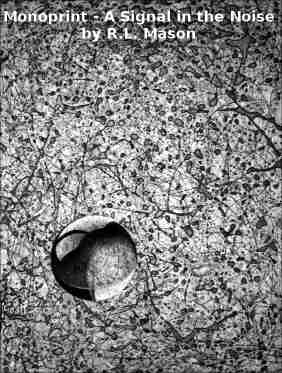
Monoprint - A Signal in the Noise by R.L. Mason
Writing this book has been a personal adventure of the mind which is why it is written in the first person. The tale unfolds roughly in the sequence of the adventure with recollections and research inserted where they seemed to fit best. The initial motivation grew out of ten years worth of conversation with Gordon Chism whose own adventure is included in chapter 2. Gordon is a firm believer in an alien presence, and if I had been in his shoes, I might be too. However, I am a natural born skeptic. I am sure Gordon’s account is accurate, but I had doubts about his interpretation. So I had to ask myself “okay, what did he see?” Chapter 3 is a summary of my first attempt at answering that question, and although it was an interesting exercise, it ended up inconclusive. in succeeding chapters I wander off in other directions, explore other avenues, and learn much in the process. eventually, in chapter 13, I come full circle and return to my starting point armed with new knowledge and what I believe is a unique perspective. In short, what we have here is a puzzle. I have always enjoyed trying to solve puzzles, and in this case the reader is invited along for the adventure.
Citations
1 [07] p. 198
2 [13] p. vii
Categories
- THE GALLERY
- Uncle Rob's Art
- 3D Works (stills) I
- 3D Works (stills) II
- 3D Works (stills) III
- 3D Works (video)
- Design & Abstract I
- Design & Abstract II
- Design & Abstract III
- Figurative Works I
- Figurative Works II
- Landscapes I
- Landscapes II
- Largest Art Project
- Nautical and Marine Images (video)
- Nautical and Marine Images I
- Nautical and Marine Images II
- Nautical and Marine Images III
- Nautical and Marine Images IV
- Portraits
- Still Life Images
- Stump Hollow Photo Essay I
- Stump Hollow Photo Essay II
- Uncle Rob's Mendocino Shop
- The Five Sense Series
- Irene's Creations
- Works by Don Mason
- Works by Don Mason II
- Works by Joseph de Borde
- Painting by Albert Robbins
- Art by Leslie Masters Villani
- Paintings by Nellie Harriet Parker
- The Art of Bee Yearian
- Works by Evie Wilson
- Uncle Rob's Art
- SCHOONER MOON BOOKS
- SEA STORIES
- ONE DOZEN AND TWO ESSAYS
- Cousinhood
- Art by Definition
- Cake Mixed Economy
- Marriage Anyone?
- Sex and/or Violence
- Searching for Truth
- The Philosophical Roots of Science
- Stepping Stones and Stumbling Blocks
- On Being Good
- Teaching By Example
- The Basic Law of Civilization
- Where Goeth Evil?
- A Modern Empircal "Religion"
- Knowledge as Wealth
- PAPERS AND ARTICLES
- FAMILY STORIES
- BOOK REVIEWS
Archive
- December 2021
- October 2020
- June 2020
- September 2019
- July 2017
- March 2017
- December 2016
- November 2016
- October 2016
- August 2016
- July 2016
- June 2016
- May 2016
- March 2016
- February 2016
- February 2015
- January 2015
- February 2014
- December 2013
- November 2013
- August 2013
- June 2013
- August 2012
- July 2012
- April 2012
- March 2012
- February 2012
- November 2011
- September 2011
- June 2011
- May 2011
- April 2011
- March 2011
- February 2011
- January 2011
- December 2010
- November 2010
- October 2010
- September 2010
- August 2010
- July 2010
- June 2010
- May 2010
- April 2010
- March 2010
- February 2010
- January 2010
- December 2009
- November 2009
- October 2009
- September 2009
- August 2009
- July 2009
- June 2009
- May 2009
- April 2009
- March 2009
- February 2009
- January 2009
- December 2008
- November 2008
- October 2008
- September 2008
